(New York) – Available evidence strongly suggests that Syrian government forces were responsible for chemical weapons attacks on two Damascus suburbs on August 21, 2013. These attacks, which killed hundreds of civilians including many children, appeared to use a weapons-grade nerve agent, most likely Sarin.
The 22-page report, “Attacks on Ghouta: Analysis of Alleged Use of Chemical Weapons in Syria,” documents two alleged chemical weapons attacks on the opposition-controlled suburbs of Eastern and Western Ghouta, located 16 kilometers apart, in the early hours of August 21. Human Rights Watch analyzed witness accounts of the rocket attacks, information on the likely source of the attacks, the physical remnants of the weapon systems used, and the medical symptoms exhibited by the victims as documented by medical staff.
“Rocket debris and symptoms of the victims from the August 21 attacks on Ghouta provide telltale evidence about the weapon systems used,” said Peter Bouckaert, emergencies director at Human Rights Watch and author of the report. “This evidence strongly suggests that Syrian government troops launched rockets carrying chemical warheads into the Damascus suburbs that terrible morning.”
The evidence concerning the type of rockets and launchers used in these attacks strongly suggests that these are weapon systems known and documented to be only in the possession of, and used by, Syrian government armed forces, Human Rights Watch said.
Special Feature: Map of Impact Zones, Photo Essay, Diagram of Chemical Rocket >>
Human Rights Watch analyzed publicly posted YouTube videos from the attacked areas as well as higher-resolution images of weapon remnants provided by a local activist in Eastern Ghouta. Two separate surface-to-surface rocket systems believed to be associated with the delivery of chemical agents were identified. The first type of rocket, found at the site of the Eastern Ghouta attacks, is a 330mm rocket that appears to have a warhead designed to be loaded with and deliver a large payload of liquid chemical agent. The second type, found in the Western Ghouta attack, is a Soviet-produced 140mm rocket that, according to reference guides, has the ability to be armed with one of three possible warheads, including one specifically designed to carry and deliver 2.2 kilograms of Sarin.
The Syrian government has denied responsibility for the attacks and has blamed opposition groups, but has presented no credible evidence to back up its claims. Human Rights Watch and arms experts monitoring the use of weapons in Syria have not documented Syrian opposition forces to be in the possession of the 140mm and 330mm rockets used in the attack or their associated launchers.
While Human Rights Watch was unable to go to Ghouta to collect weapon remnants, environmental samples, and physiological samples to test for the chemical agent, it has sought technical advice from an expert on the detection and effects of chemical warfare agents. The expert reviewed accounts from local residents, the clinical signs and symptoms described by doctors, and many of the videos that were taken of the victims of the August 21 attacks.
Three doctors in Ghouta who treated the victims told Human Rights Watch that victims of the attacks consistently showed symptoms including suffocation; constricted, irregular, and infrequent breathing; involuntary muscle spasms; nausea; frothing at the mouth; fluid coming out of noses and eyes; convulsing; dizziness; blurred vision; red and irritated eyes and pin-point pupils (myosis). Some young victims exhibited cyaonis, a bluish coloring on the face consistent with suffocation or asphyxiation. None of the victims showed traumatic injuries normally associated with attacks using explosive or incendiary weapons.
Such symptoms, and the lack of traumatic injuries, are consistent with exposure to nerve agents such as Sarin, Human Rights Watch said. There is laboratory evidence that Sarin gas has been used in a previous attack in April on Jobar, near Damascus, when a photographer for Le Monde newspaper who was present at the time later tested for exposure to Sarin.
The use of chemical weapons is a serious violation of international humanitarian law. Although Syria is not among the 189 countries that are party to the 1993 Convention on the Prohibition of the Development, Production, Stockpiling, and Use of Chemical Weapons and on their Destruction, it is a party to the 1925 Geneva Gas Protocol. Customary international law bans the use of chemical weapons in all armed conflicts.
The August 21 attacks on Ghouta are the first major use of chemical weapons since the Iraqi government used chemical weapons on Iraqi Kurdish civilians in Halabja 25 years ago, Human Rights Watch said.
“The increasingly evident use of chemical weapons in Syria’s terrible conflict should refocus the international debate on deterring the use of such weapons and more broadly protecting Syria’s civilian population,” Bouckaert said.








